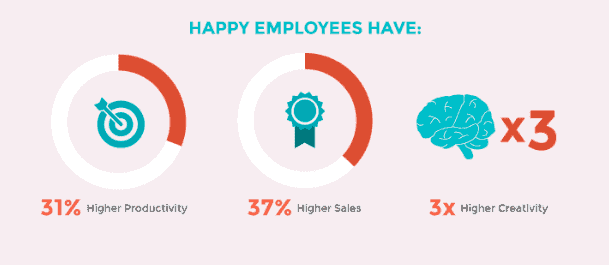A recent Gallup Study found that employee dissatisfaction is causing global enterprises to take a hit—a three hundred million dollar hit per year, to be specific.
The problem
Where does this cost stem from? For starters, happy employees have 31% higher productivity with 3 times higher creativity levels than less satisfied coworkers (Good & Co.). Less productivity and creativity means less work gets done, leading to increased overtime and even hiring to pick up the slack. More hours worked only fuels the dissatisfaction (and overtime pay expenses), and a vicious cycle is born. These unhappy employees are inevitably more likely to leave the company all together, which means incurred turnover costs, and more money and resources to be spent in HR. If that isn’t bad enough, in comparing the top 25% most satisfied teams versus the bottom 25% in the average American office, Gallup data revealed that the bottom sector has nearly 50% more accidents and 41% more quality defects, therefore incurring more liabilities, health care costs, and accruing far more sick days than the satisfied workers. #SOS.

So employee dissatisfaction is bad. Very, very bad. But how can companies address these daunting statistics and take action to keep employees happy? Human resource teams and office managers have responded with some quick fixes; like free lunches, company happy hours, an in-office-gym, and some even as bold to ditch the cubicles and redesign the office space. While all of these are commendable efforts, and of reasonable cost according to the employee happiness calculation—what if there was one simple way to boost employee satisfaction without the construction or cost, in fact it increased profits, all while expanding employee’s skill sets, providing networking opportunities and skyrocketing creativity? Read on, my friend.
The solution
What do companies like Facebook, Buffer and Netflix have in common? Well for starters, they are considered some of the most progressive and innovative companies in the world. Take a closer look, and the same holds true in their HR policies. While the list included policies like good compensation, room for task variety and job growth, benefits & perks, and positive social feedback, one particular strategy was ranked as the most critical in boosting company morale: freedom and autonomy.
Let’s get flexible
In the footsteps of our innovative trailblazers, more and more companies are introducing policies which allow employees to work from home, or remotely. And why not? With the corporate world being so strongly dominated by the internet, and handy technologies like smartphones and tablets (with a little help from our good friend, Wi-Fi), it’s possible to complete the same tasks one would perform in the office, virtually anywhere. This silver bullet has single-handedly proven as the most impactful strategy in increasing employee reported happiness. HR experts and psychology analysts attribute the phenomenon to personal empowerment: letting workers set their own hours and even determine their own vacation allowances makes them feel more involved and engaged in their role. A 2007 Penn State University study involving nearly 13,000 employees showed that telecommuting improved job satisfaction, performance and turnover intent, and “had no generally detrimental effects on the quality of workplace relationships.”
Nathaniel Koloc, co-founder and CEO of ReWork, explains that workplace flexibility directly translates into productivity (HBR). A Stanford University and Beijing University study found that Chinese call-center workers who had the option of work from home took fewer breaks and were more efficient. A similar study from LRN found that organizations who allowed their employees more freedom were 10-20 times more likely to outperform companies with low freedom scores.
The gains ($$$)
According to Koloc, companies that allow employees to work remotely at least three times per month were more likely to see revenue growth at the end of the quarter. A work-at-home policy also can lower a company’s costs by requiring less office space. Instead of increasing your infrastructure costs with a nifty new office gym, why not put that money towards hiring top-notch talent who can work remotely? After all, better to invest in your company’s productivity than bricks and mortar, am I right?
Make way for coworking
Of course, there are some disadvantages of working from home—frequent distractions and a potentially un-motivating environment take the cake. Companies like Yahoo even restricted the work-from-home policy for this very reason. However, the revolutionary trend of coworking spaces is rapidly occupying its niche in the telecommuting world and eliminating the “work-from-home slump” risk. These community-driven shared offices provide workers of any trade, from freelancers to CFOs, all the amenities of a traditional office, with a digital nomadism twist. From conference spaces for lease, to private offices for rent and networking events or workshops—read more about why people love coworking here.
About Us
Bridgeworks is a vibrant coworking space right by the beach on Long Island, NY, offering office space for rent, meeting rooms, networking events and much more. Bridgeworks Long Beach also features countless communal spaces, cafés, lounges and added bonuses like social bikes and ping pong. Corporate NYC commuters and digital nomads alike take advantage of the new creative hub to network, boost productivity, and of course, cut the commute time. Learn more at www.bridgeworkslongbeach.com.



